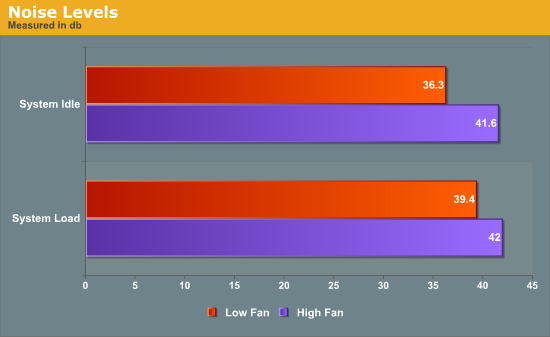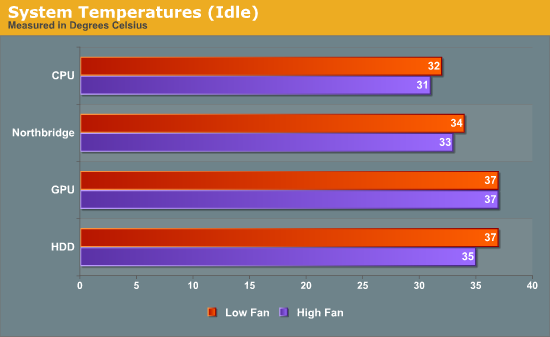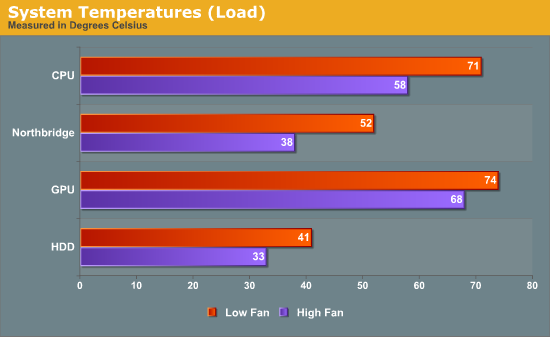SilverStone GD04 HTPC Case: Cool, Not Quiet
by Dustin Sklavos on December 25, 2010 12:00 AM EST- Posted in
- Cases/Cooling/PSUs
- HTPC
- SilverStone
- GD04
Thermal and Noise Testing
In testing the SilverStone GD04, I actually added components you're not going to see in the gallery but wound up needing just to keep the noise level down: the Zalman CNPS7000, which with the included FanMate controller was kept running at a low setting, and a Xigmatek Mono-Cool fan controller, the only controller I could find on NewEgg that fit into an expansion slot instead of a drive bay. The Xigmatek controller has headers for three fans, making it seem perfectly tailored to this task. Noise was measured using an Extech SL10 sound meter, while temperatures were measured conventionally using HWMonitor. The test system specs are as follows:
| Test Configuration | |
| CPU | AMD Athlon II X4 640 |
| Motherboard | ASUS M4A78LT-M AM3 MicroATX |
| Graphics Card | EVGA GeForce GTS 450 |
| Memory | 2x2GB DDR3-1333 |
| Drives |
LG HD-DVD/Blu-ray/DVDRW Combo Drive 1x Western Digital Caviar Blue 640GB |
| CPU Cooler | Zalman CNPS7000 |
| Power Supply | PC Power & Cooling 500W |
These aren't loud components to begin with, but remember: this is a media center case with three 120mm fans, and at least in my apartment it's going to be out in the open. Silence is paramount for a build like this. To generate load temperatures and noise, I ran 3DMark06 in a loop with Prime95 in the background and left it running for fifteen minutes at a time. The system was tested with the fan controller at its lowest and highest settings, and the sound meter was positioned one foot away from the tower, on a tripod, pointed directly at the side of the case.

While the fan noise wouldn't be a major issue for a normal PC that's probably going to be hidden under or near a desk, a media center PC really does need to run quieter than this. The first time I powered it up I was actually alarmed at how loud it was, and even though the character of the noise is a low whooshing, it's nonetheless very audible. Not good. So how are the thermals, then?


Thermals are actually pretty decent; remember this is a heavy artificial load being placed on the system. With the fans running at full bore everything's actually pretty good, but at low speed the processor's temperature becomes a bit worrying. Odds are good in actual use the CPU won't get this hot, but it's still not ideal. The idle temperatures are excellent at least.










68 Comments
View All Comments
RobertR13 - Saturday, December 25, 2010 - link
How can anyone choose to post noise levels, with no frame of reference? We have a bunch of pretty graphs and lot of nice numbers, but what are we supposed to compare them to? And what is the noise floor of the test area? And who on earth measures exclusively at one foot and exclusively on the side of the case? That would be like wanting to know how loud it is driving a car, and measuring sound a foot from the exhaust. You don't drive from behind the car and you don't watch movies from a foot away from the side of your computer.The writing itself isn't terrible, but a bit obviously amateurish, and the whole article is just a subjective analysis.
RobertR13 - Saturday, December 25, 2010 - link
Oh, and I nearly forgot, you can put some VERY long power supplies in this case, you just have to swap out the side fan. The side of the case is drilled for both 120mm fans(as included) and 80mm fans for those with longer power supplies who would still like some ventilation on that side of the case.8steve8 - Monday, December 27, 2010 - link
agreed, noisy compared to what?RobertR13 - Saturday, December 25, 2010 - link
I'm forced to continue making observations about this article in re-reading it.In the first paragraph the author states that he chose not to go with another case because it didn't have any vibration dampening for the optical drive bay, so he chose this case, which has no vibration dampening for the optical drive bay. Wait, what?
Also, Silverstone pretty plainly has stated in the past that the extra expansion slot above the power supply was designed for expansion cards to high end audio devices like the Emu-1212m or the Asus Xonar HDAV series with daughter cards, but that it would work with any other expansion items, like SATA or USB or what-not.
What research was one before purchasing this case?
Finally, I noticed that there is no sound measurement given with just the case fans powered up and not the CPU or GPU fans powered up, like that's not going to make a HUGE difference in the sound levels and types produced.
Hrel - Saturday, December 25, 2010 - link
he said he didn't want to have to put tape on the led on the cd drive, which is why he chose this case, read more carefully.RobertR13 - Saturday, December 25, 2010 - link
Maybe you should re-read the article, he said he chose this case over the GD-05 because he wanted to hide the LED on the ODD, but that his whole reason for looking for a new case was because his LG BD\HD-DVD drive was getting too noisy so he wanted a case with some sound dampening on the ODD bay, which this doesn't have.Stuka87 - Saturday, December 25, 2010 - link
They always measure from the same distance, this is so that all reviews that have sound levels are measured in the same way.As for frame of reference, a deciBell is a deciBell. What frame of reference do you need?
As for noise floor, any half decent tester allows you to calibrate out the ambient noise level.
RobertR13 - Saturday, December 25, 2010 - link
1: Who is they, there are no other people or cases in this article2: I'm fine with measuring from a fixed distance, but measuring from 1 foot away, from the side is rediculous.
3: dB are a standard frame of measurement, sure, but if you have a purpose built theater with a noise floor of 11dB and the case makes 36dB it is going to seem a lot louder than if you are just putting it in your family room with a noise floor of 25+dB.
4: That would invalidate the experiment all together because if you wipe out the noise floor, then you have to say so, and state what the noise floor is so that people can actually use the number for something, and two, if it screens out tones, that you are telling it to consider ambient noise, then you might be missing a specific sound frequency the fans are making.
MeanBruce - Saturday, December 25, 2010 - link
You know my floor is pretty noisy, of course that could be my neighbors downstairs.C'DaleRider - Saturday, December 25, 2010 - link
To answer your petulant, childish nitpciking, which is making you look like the 12 year old you seem to want to be noticed as,1. They are the testers at Anandtech. They have a standard set of testing requirements, such as noise checked at 1 ft. distance, to make the different testers' findings be comparable to other findings from other testers.
2. Why? If anything, it presents a worst case scenario.....the noise perception will only get better as distance increases.
3. Why worry about the floor/ambient noise? It'd only be worth noting if the ambient noise was too high to hear the noise the fans in the case generated....and then it'd be worth noting. Otherwise, once the generated noise overcomes ambient noise, the ambient noise becomes irrelevant. Noise, in this case, isn't additive.....such as adding ambient to case generated noise. Doesn't work like that.
4. Just too stupid an argument to respond to.